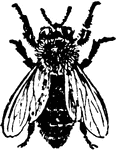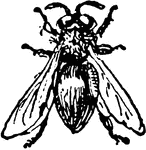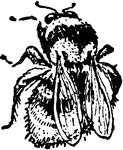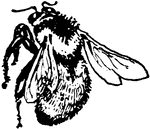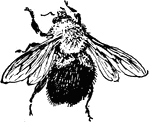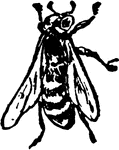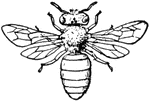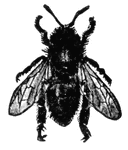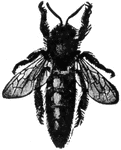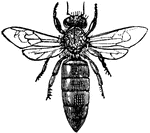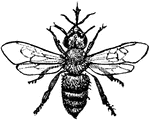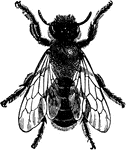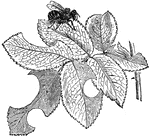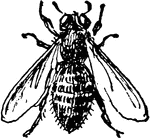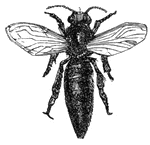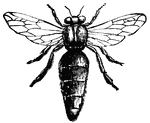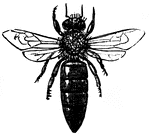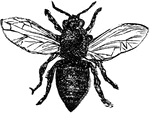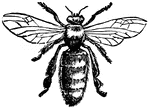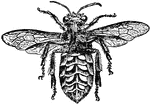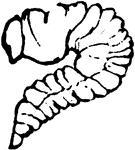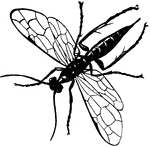This ClipArt gallery offers 197 pictures of numerous insects from the order Hymenoptera, including ants, bees, wasps, hornets, sawflies, and ichneumon.
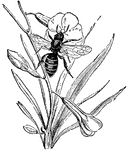
Bee Pollinating a Flower
"Bee, the common name given to a large family of hymenopterous or membranous-winged insects, of which…
Carpenter Bee
Carpenter bees are large, hairy bees distributed worldwide. Their name comes from the fact that nearly…
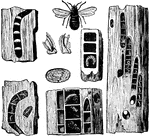
Carpenter Bee, Pupae, Eggs, Galleries and Nests
"The Carpenter Bee, or Wood Piercer, hollows out galleries in decayed wood, and builds in them cells…
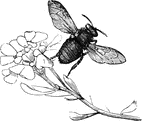
Drone Bee
"The working bee, for collecting wax, enters a flower, the stamens of which are loaded with pollen.…

Drone Bee
"Bee is the common name given to a large family of hymenopterous or membranous-winged insects, of which…

Female or Queen Bee (Apis Mellifica)
"The female is smaller than the male, and has a longer body than the working bee; the wings are shorter…

Honey Bee
"They are said to have originated in Greece, but have since spread all over the world; they live in…

Larva of the Bee
"As the larva increases in size, its food is made to acquire a more decided taste of honey. In the space…

Leaf-Cutter Bee
A leaf-cutter bee, Megachile species. Leaves cut from leaf-cutter bee in a burrow in a dead branch.
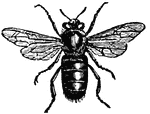
Male or Drone Bee (Apis Mellifica)
"The males are larger and more hairy than the working bee, emitting a sonorous and buzzing sound, have…
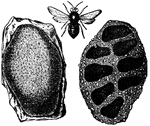
Mason Bee and Nest
"The Mason Bees build their nests against the walls with tempered earth, which becomes very hard."

Mining Bee
Mining bees, or digger bees, (familys Andrenidae & Anthophoridae) nest in burrows in the ground. Each…
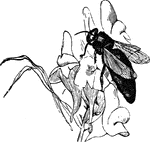
Queen Bee
"The queen bee is larger and longer than the other bees; she moves in a slow and majestic manner, and…
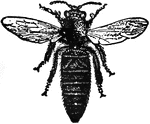
Queen Bee
"Bee is the common name given to a large family of hymenopterous or membranous-winged insects, of which…
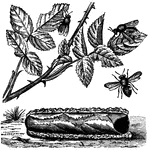
Rose Megachile Bee (Megachile Centuncularis)
"The Leaf Cutting Bees make their nests in tubes lined with the leaves of the rose, the willow, the…

Worker Bee
"Bee is the common name given to a large family of hymenopterous or membranous-winged insects, of which…

Working Bees
""The working bee, for collecting wax, enters a flower, the stamens of which are loaded with pollen.…
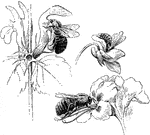
Bees Visiting Flowers
"Bees visiting flowers. At the left, a bumblebee on the flower of the dead nettle; below, a similar…
Honey Bees
"Honey bee (Apis mellifica). a, queen (perfect female); b, worker (imperfect female); and c, drone (male)."…
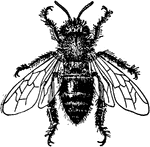
Honey Bees
Bees are flying insects closely related to wasps and ants. Honey bees (or honeybees) are a subset of…

Honey Bees
Bees are flying insects closely related to wasps and ants. Honey bees (or honeybees) are a subset of…
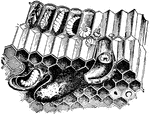
Honey Bees
Bees are flying insects closely related to wasps and ants. Honey bees (or honeybees) are a subset of…
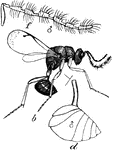
Male Chalcid Wasp
The male chalcid wasp (Eurytoma prunicola) is a parasitoid in the family Chalcididae.
